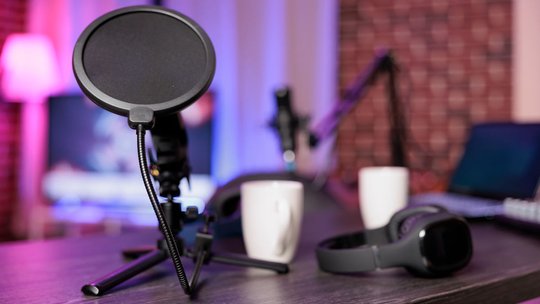Blog
10 Important Podcast Metrics to Measure Your Podcast's Success

Veröffentlicht am 27.5.2024 von Babalola Alabi
Podcasting“How well is your podcast doing? What are the reactions of your audience to your podcast? What can you do to make your audience love your podcast more?” These are common questions that might run through your mind as a podcaster, especially if you have business goals for your podcast. And even if you create podcasts for fun, your instincts will still love to know how great your podcast is doing.
This is where podcast metrics come in.
Podcast metrics are measurements or data points you use to assess the performance and success of your podcasts. In this article, we’ll discuss the most important podcast metrics you should focus on, along with some actionable steps and strategies you can use to make the podcast better.
10 Podcast Metrics to Measure Your Podcast Success
Now that you know how important it is to track your podcast metrics, let’s discuss the important ones.
1. Total downloads
Total downloads is the easiest and most common podcast metric to track. It is an important metric that shows the number of times your podcast episode has been downloaded. However, total downloads is a basic and unreliable metric to focus on. That’s because the fact that someone downloaded your podcast doesn’t mean they listened to it. Podcast hosting companies usually don't have direct access to players or devices, which limits their data on play counts and multiple downloads by the same user.
2. Listener engagement
Your podcast success relies on several performance metrics, but your audience engagement is by far the most important. Unlike total downloads, listener engagements give precise data on the number of listeners, time spent listening to the podcast and drop-off rate.
For example, if most of your audience stops listening to your podcast—or there’s a high drop-off rate—at a particular podcast segment, you might have to review your content strategy or make some changes to your podcast structure. Other listener engagement data include your audience’s response rate to polls, Q&As, feedback and ratings.
When a listener's listening session on Apple Podcasts is at least 20 minutes (or 40%) of a podcast episode, the platform records audience engagements. When the listening session is at least 60 seconds on Spotify, it is recorded as “streams.”
3. Downloads per episode
Downloads per episode is a more informative metric that shows you the number of downloads each of your podcast episodes has. If the metrics say you’ve had 5000 total downloads for 50 podcast episodes, you might assume that you’ve had 100 downloads per episode. Realistically, that’s wrong. Some podcast episodes might get higher or lower download counts for some reasons, which should be studied and checked to improve your content and podcast structure.
4. Downloads over time
Downloads over time shows you how your podcast has performed over a long time. Releasing a podcast episode doesn’t mean all your audience will view and listen to it immediately. A new listener might bump into one of your latest episodes and decide to view older ones after getting hooked by the content. If you checked your downloads per episode metrics alone, you’d think the new listener listened to the old episode immediately after it was released, whereas that’s not the case. Downloads over time shows you which podcast episode has the longest shelf life and how the show has grown.
5. Subscriber
Subscribers (or followers) are people who have clicked the subscribe (or follow) button to receive automatic updates or notifications whenever a new podcast episode is released.
Most times, it shows how much people love your podcast and are willing to hop on the next episode as quickly as possible.
6. Listener countries and demographics
Tracking your listeners’ countries and demographics helps you create content that they can relate to. For several reasons like cultural interests, language preferences and regional topics, the way you’ll speak and create content for Australians will be totally (or slightly) different from that for Americans. Also, demographic data such as age, gender, and interests provide insights into who your listeners are and what they're interested in. You can create a form (using Google Forms or other websites) to get real-time data on your listener’s demographics. The form should include their age, gender, interests, occupation, and how or where they found your podcast.
7. Website traffic
Beyond your audio content, there are other metrics you can track, one of which is your website traffic. Tracking your website traffic gauges the effectiveness of your online presence and promotional efforts. If your website has high traffic, then your search engine optimisation is solid. This means when people search for podcast topics on search engines like Google, your website is one of the top websites that shows up.
8. Bounce rate
Having lots of website traffic doesn’t mean that your audience spends more time on your website. Bounce rate is a metric that measures the percentage of visitors who land on a webpage and then leave without interacting further with the site or visiting any other pages within the same site.
9. Conversion rate
Conversion rate refers to the percentage of your audience that takes a desired action after engaging with your podcast. For example, if you sell merchs and advertise them on your podcast, the conversion rate will be the percentage of people that placed an order for the merch.
10. Social media followers
This is another metric that is also worth tracking because it shows how interested your audience is in your podcast. Just like your subscriber growth, track your follower count on social media too.
Ready to grow your podcast? Here’s the ultimate tool!

One way you can grow your podcast is by sharing it on your social media platforms with the most appealing video. It helps boost your visibility and accessibility and also reach a wider audience. With SoundMadeSeen’s innovative technology, you can effortlessly transform your podcast episodes into engaging video clips optimised for platforms like Instagram reels and TikTok.
Even if you only have audio content, SoundMadeSeen can create the best video content from it too.
You can also generate written content like blog content, show notes and social media captions automatically from your audio or video file. Sign up to SoundMadeSeen now to see for yourself.
FAQs on Podcast Metrics
What are the key podcast metrics?
- Listener engagement
- Downloads per episode
- Downloads over time
- Subscriber growth
- Listener countries and demographics
- Conversion rate
How do you measure a podcast's success?
Measuring your podcast success depends on expected results and your definition of success. However, common podcast metrics that could be of great advantage include listener engagement, subscriber growth, downloads per episode and downloads over time.
Beginnen Sie kostenlos zu erstellen
Verwandeln Sie Ihren Podcast, Ihr Hörbuch oder Ihren Vortrag in teilbare Video- und Textinhalte
Probieren Sie es heute aus


